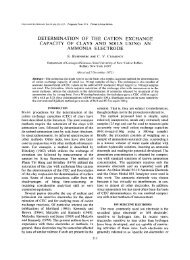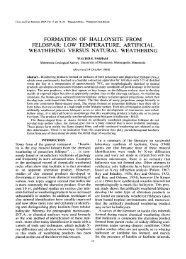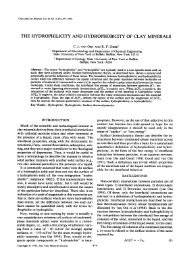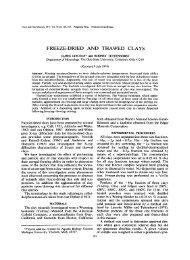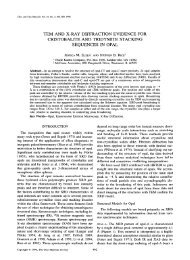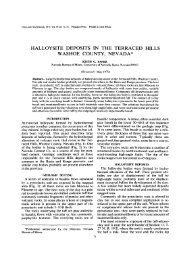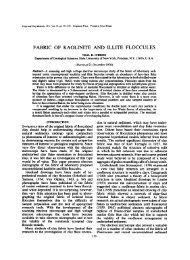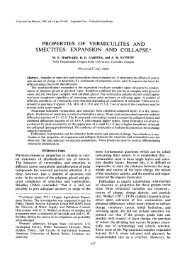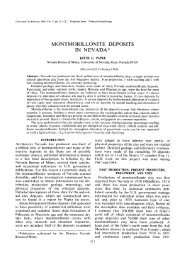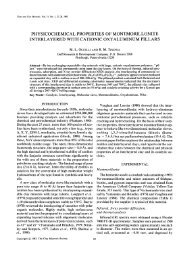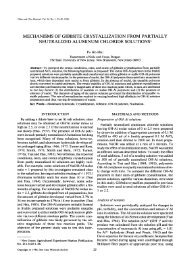mineralogical and geochemical study of clay mineral ...
mineralogical and geochemical study of clay mineral ...
mineralogical and geochemical study of clay mineral ...
Create successful ePaper yourself
Turn your PDF publications into a flip-book with our unique Google optimized e-Paper software.
366 J. LUCAS <strong>and</strong> G. ATAMAN<br />
covered by a shallow epicontinental sea bounded<br />
on the western side by the Massif Central <strong>and</strong> on<br />
the east by the edge <strong>of</strong> the continental slope. This<br />
epicontinental sea faced the deep Mesogean sea,<br />
the location <strong>of</strong> the present Alps. The Jura Basin<br />
was separated from the Alpine Sea by a shallow<br />
sill or bar at the edge <strong>of</strong> the Continental Shelf<br />
(Fig. 1).<br />
supplied with detrital sediments from the Massif<br />
Central to the west <strong>and</strong> with evaporite deposits<br />
caused by supersaturation <strong>of</strong> evaporating sea<br />
water.<br />
STUDY OF CLAY MINERALS (LUCAS, 1962)<br />
In the s<strong>and</strong>stone facies, adjacent to the Triassic<br />
coast line, the <strong>clay</strong> <strong>mineral</strong>s are principally<br />
Massif Subsident basin Bar Alpine<br />
central <strong>of</strong> juro sea<br />
Principally, carbonate sediments <strong>of</strong> the Alpine<br />
facies were deposited in the deep sea while on the<br />
continental shelf, sedimentary deposits <strong>of</strong> the<br />
Germanic facies accumulated. The thickness <strong>of</strong><br />
the formations shown by the drill holes demon-<br />
strates that an important subsidance in the vicin-<br />
ity <strong>of</strong> Laveron affected the Continental Shelf, but<br />
it is likely that sedimentation took place constantly<br />
under only shallow water conditions.<br />
In this topographic context, it is certain that<br />
the only detrital continental source <strong>of</strong> sediment was<br />
the Massif Central on the western flank <strong>of</strong> the<br />
basin. On the other side <strong>of</strong> the basin, the epi-<br />
continental sea communicated freely with deep<br />
sea. It is possible that in some places a submarine<br />
shelf separated the two environments, but it is<br />
more probable that the edge <strong>of</strong> the continental<br />
plateau itself, where the bar acted as a sill,<br />
constituted a sufficient barrier.<br />
Under the warm, although certainly not arid,<br />
Triassic climate, evaporation was intensive <strong>and</strong><br />
the water supplied to the continent was insuffici-<br />
cient to replenish the amount lost by evaporation;<br />
thus a permanent current was created from the<br />
open sea toward the sea <strong>of</strong> the continental plateau.<br />
This process <strong>of</strong> increasing salinity is similar to<br />
that described by Ochsenius (1877) <strong>and</strong> by Sloss<br />
(1953). On the western side <strong>of</strong> the basin, the<br />
salt water was diluted by fresh waters draining<br />
from the continent which precluded precipitation<br />
<strong>of</strong> salt deposits.<br />
In summary, Jura Basin sediments were de-<br />
posited on a subsiding continental shelf <strong>and</strong> were<br />
Fig. 1. Section across reconstructed Triassic Jura Basin.<br />
J<br />
degraded illite which, in X-ray diffractograms,<br />
show a 10A reflection, broad <strong>and</strong> open toward<br />
small angles. This illite is accompanied by small<br />
percentages <strong>of</strong> kaolinite <strong>and</strong> chlorite, also poorly<br />
crystallized. Electron micrographs <strong>of</strong> these <strong>clay</strong>s<br />
reveal very small particles without apparent crystal-<br />
line shapes <strong>and</strong> concentrated in rounded aggre-<br />
gates. We conclude that these <strong>mineral</strong>s represent<br />
the detrital contribution originating in the exposed<br />
rocks <strong>of</strong> the Massif Central.<br />
Going basinward from the coast, the facies<br />
become less s<strong>and</strong>y <strong>and</strong> the composition <strong>of</strong> <strong>clay</strong><br />
<strong>mineral</strong>s progressively changes. Mixed-layer<br />
<strong>mineral</strong>s occur, as evidenced by broadening <strong>of</strong> the<br />
illite reflection toward small angles. Progressing<br />
basinward, a diffuse reflection appears between<br />
10 <strong>and</strong> 14A, <strong>and</strong> then the reflection tends to<br />
become distinct nearer 14 _A <strong>and</strong> forms a mixed-<br />
layer <strong>mineral</strong> <strong>of</strong> the (14c-14~) type.<br />
Still farther from the coast, this mixed-layer<br />
<strong>mineral</strong> becomes more regular, resulting in an<br />
excellent corrensite. But the evolution is not<br />
finished because corrensite gives way to a new<br />
mixed-layer <strong>mineral</strong>, more like chlorite, <strong>and</strong> <strong>of</strong> a<br />
(14c-14~;) type. Then, in the drill hole at Laveron,<br />
in the thickest part <strong>of</strong> the sedimentary basin, the<br />
mixed-layer <strong>mineral</strong>s give way to a well-crystal-<br />
lized chlorite which has strong, sharp reflections.<br />
Paralleling this progression <strong>of</strong> the 14 A population,<br />
X-ray reflections <strong>of</strong> illite also become sharper <strong>and</strong><br />
approximate those <strong>of</strong> a well-crystallized mica.<br />
This evolution may be summarized as follows:<br />
Degraded illite <strong>and</strong> chlorite ~ irregular (14c- 14M)



